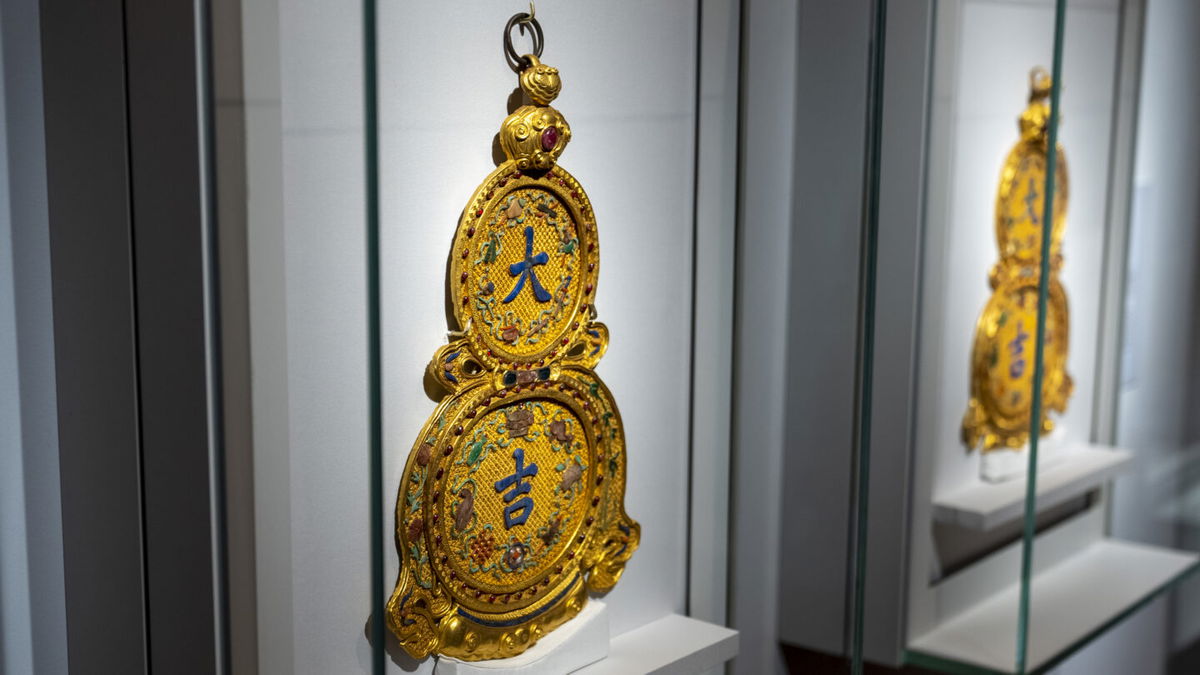How to celebrate Lunar New Year like an Emperor

Rebecca Cairns and Kristie Lu Stout, CNN
It’s Lunar New Year. Wearing their finest festive clothes, an 18th century family sits down to feast on a lavish banquet in a room adorned with auspicious signage.
This scene will sound familiar to many of the families, across China and the globe, enjoying their own festivities, traditions and symbolic foods over the holiday period, which began Sunday. But there are some significant differences: This hotpot dish is ornately decorated in cloisonné enamel, the signs are encrusted with turquoise, jade, and rubies, and the patriarch’s fashion choice is a silk robe with dragon motifs hand-stitched in gold thread. It’s a Lunar New Year fit for an emperor.
“It’s a symphony of the senses,” said Daisy Wang, deputy director of the Hong Kong Palace Museum, where these Qing dynasty-era treasures are displayed in a second-floor gallery focused on daily life in Beijing’s imperial palace.
“You have to imagine what the Emperor and his family would hear, what they would taste, what they would touch, what aromas they would smell,” Wang added. “We have to use all our senses to imagine what happened 300 years ago, inside the Forbidden City.”
The $450-million building opened last summer and has a rotating collection of more than 900 treasures on loan from Beijing’s Forbidden City, from rare ceramics to delicate scroll paintings. The museum is marking its first Lunar New Year by inviting visitors to see how one of China’s longest-ruling emperors celebrated the occasion, through the auspicious objects on display.
Decoding the past
The Qing dynasty’s fourth emperor, the Qianlong Emperor, was “one of the most powerful rulers on Earth in the 18th century,” said Wang. “He ruled over a vast territory, with a population of probably over 300 million.”
His reign, from 1735 to 1796, was also marked by flourishing arts and creativity in the country. Known to be erudite and cultured, he published over 40,000 poems during his lifetime, and amassed an enormous collection of antique and commissioned imperial artworks during his six-decade rule.
Everywhere you look at the Palace Museum exhibition, the emperor’s penchant for luxury is on show, from hanging panels featuring jade floral motifs to a pair of golden gourd decorations. The latter, which are embedded with semi-precious stones and featuring the Chinese characters for “great fortune,” are among more than 60 gourd-shaped decorations commissioned by the Qianlong Emperor to adorn the Forbidden City during the Spring Festival in 1746 alone.
As with many artworks, they contain “hidden meanings,” said Wang. A symbol of fertility, bottle gourds, or “hulu,” have a name that sounds similar to the Chinese words for “auspicious” and “wealth,” she added.
The emperor wasn’t just commissioning artworks, though: His extravagant taste extended to his wardrobe. “(He) never commissioned (only) a single piece of clothing,” said Wang. “It always had to be two, four, six.”
Known to change his outfit up to seven times a day, one standout garment featured in the exhibition is a robe adorned with intricately hand-stitched dragons flying among wispy, clouds in gold-wrapped thread.
Familiar traditions
With a taste for vast banquets, which often comprised hotpot, dumplings and roast duck, the Emperor’s dining habits — and the serving dishes and utensils used — will be familiar to many. According to Wang, Qianlong loved hotpot so much that he ate 200 such meals in one year, which some believe contributed to his longevity (he died in his late eighties).
Lunar New Year feasts were particularly special for the Emperor because it would be one of the very few occasions he was allowed to eat in the same room as family and friends. “Because of safety concerns, he usually ate alone,” said Wang.
The imperial items he used, beyond being gilded and jewel-encrusted, also reveal how many traditions have remained the same.
“One of the things that surprised me is how similar the way he celebrated the Lunar New Year is to our practice today.
“I hope that visitors will come and connect these ancient objects with their own lives.”
Watch the video above for an inside look at the Lunar New Year objects on display at the Hong Kong Palace Museum.
The-CNN-Wire
™ & © 2023 Cable News Network, Inc., a Warner Bros. Discovery Company. All rights reserved.
Stephy Chung, Dan Hodge, Kevin Broad, and Zane Hosgood contributed to the video.